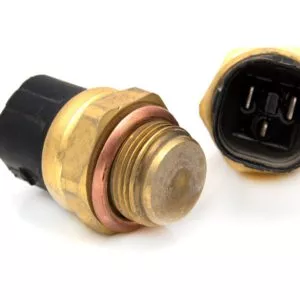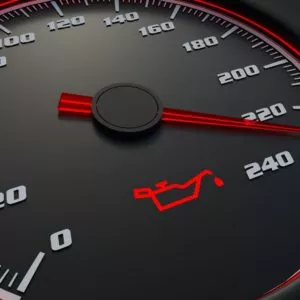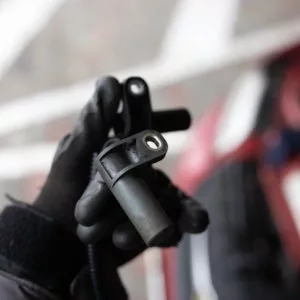One component many motorists tend to forget is the engine oil pressure sensor. This sensor is also called the engine oil sensor. Although the oil pressure sensor (OPS) is a relatively simple part, it can trigger a range of anxiety-inducing warnings on your dashboard when it fails.
If you’re experiencing one or more symptoms associated with a bad oil pressure sensor, you’ll want to address the issue right away.

Bad Oil Pressure Sensor Symptoms
Oil pressure sensors are designed to last the life of the vehicle—but that doesn’t always happen. Like any other auto part, your car’s OPS can eventually fail, resulting in some noticeable symptoms.

The most common oil pressure sensor symptoms include:
Incorrect Oil Pressure Gauge Reading
If your car is equipped with an oil pressure gauge, a faulty OPS will almost always cause the gauge to read incorrectly. You may notice that the gauge’s pointer is stuck at one end of its sweep or that the gauge works intermittently.

Oil Pressure Warning Light Is On
A faulty oil pressure sensor or oil pressure switch can falsely signal a low oil pressure condition, causing the oil pressure warning light to turn on.
Illuminated Check Engine Light
You might be wondering, “Can a check engine light come on for low oil pressure?” It absolutely can. On many modern vehicles, a computer, referred to as a control module, monitors the OPS. If the module detects a problem with the OPS, it will turn on the check engine light and store a diagnostic trouble code in its memory.
Note: A loss of engine oil pressure can cause many of the same symptoms as a faulty OPS. Running an engine with low oil pressure can quickly result in severe internal damage. You should immediately turn off the engine if the dashboard warnings indicate low oil pressure.
What Does the Oil Pressure Sensor Do?
The oil pressure sensor (also known as an oil pressure sending unit) is a pressure transducer that measures the engine’s oil pressure. As engine oil pressure changes, so does the sensor’s internal resistance.
Most older vehicles have the OPS wired directly to the oil pressure gauge. Typically, one side of the gauge receives battery power, while the OPS provides a ground on the other side. As the OPS changes its internal resistance in response to oil pressure, the gauge is forced to move.
OPS operation is a bit different on many late-model vehicles. In a typical system, the engine computer—often referred to as the powertrain control module (PCM)—receives input from the OPS. The module then relays that information to the instrument cluster, which, in turn, operates the oil pressure gauge or warning light as needed.
If the PCM detects a problem with the OPS or its circuit, it will turn on the check engine light and store a diagnostic trouble code in its memory.
Some vehicles have an oil pressure switch in addition to or in place of the oil pressure sensor. The switch closes when oil pressure drops below a certain threshold. Closing the switch causes the low oil pressure light to illuminate on the dashboard.
Note: The terms oil pressure sensor and oil pressure switch are often used interchangeably.

How to Check Oil Pressure Without a Gauge
Checking your vehicle’s oil pressure without an OPS will require an oil pressure test kit, bucket for oil, vehicle jack, wrench selection, and some experience working on your vehicle.
The process involves removing your OPS and installing the oil pressure test kit. From there, you’ll need to rev your engine. The revolutions per minute (RPM) in which you’ll need to rev your engine will vary depending on what your owner’s manual says. Your owner’s manual should indicate what pressure range your engine should have for a given RPM. Take note of the readings, remove the oil pressure test kit, and then let the engine cool once you’re done.
Is Driving With a Bad Oil Pressure Sensor Safe?
You should never assume the OPS is to blame for a low oil pressure warning on the dashboard. The issue could be an actual loss of oil pressure inside the engine.
So, to minimize the chance of costly internal engine damage, you should shut the car off immediately whenever there’s a low oil pressure warning displayed on the dash. Then have the vehicle towed to your destination of choice for diagnosis.
If you (or your mechanic) determine the vehicle has a faulty OPS, you should address the issue right away. Without a functional OPS, you’ll have no way of knowing if the engine oil pressure becomes dangerously low.
Check out our extensive selection of oil pressure sensors to find a high-quality replacement for your vehicle.
Where to Get a New Oil Pressure Sensor for Your Vehicle
If you notice any of these telltale signs, determine whether they’re pointing to a bad oil pressure sensor. You can take your vehicle to a mechanic for diagnosis or check the sensor yourself. If there’s a need to replace the part, CarParts.com has you covered with our wide array of OE-grade oil pressure sensors.
We have everything sorted out for you, as our catalog features accurate and detailed fitment information. Use our vehicle selector to check out the oil pressure sensors that fit your ride, then change the filters to further narrow them down based on your preferences.
In addition, we have several warehouses, all strategically located across the country to ensure you get your order in as fast as two business days. You also don’t have to break the bank to get a top-notch replacement, thanks to our competitive prices.
Browse our selection of oil pressure sensors and get the best deals today!
Any information provided on this Website is for informational purposes only and is not intended to replace consultation with a professional mechanic. The accuracy and timeliness of the information may change from the time of publication.
































